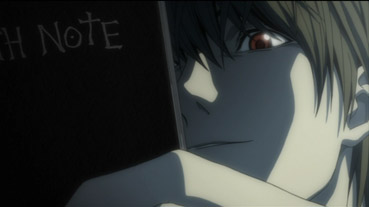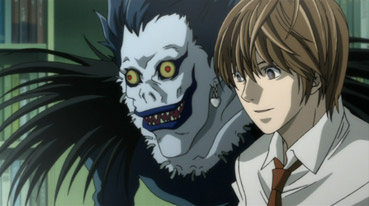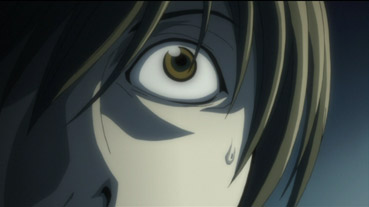|
Death Note is a long running series from Japan that started off as a serial publication in the Shonen Jump magazine which came to popularity during 2005/6. After being serialised and published as a graphic novel, the anime followed and aired from 2006 to 2007. The anime show ended its 37 episode run in June 2007 and has finally come to DVD in the UK as a double DVD package which includes the first 8 episodes.
Yagami Light is the main protagonist, who finds the Death Note after it is dropped into the human world by Ryuuk, a Death God. He is a high-school aged boy in Japan, bored due to his higher level of intellect over his peers. Light does not socially interact with others, which is seen in the feeling that he is better than others of his own age group. After getting hold of the Death Note, Light decides to cleanse society of all of its ills, starting with the execution of mass murderers who are held in prison. When the public realise what is happening, that criminals are being punished with death for their sins, the name Kira starts to spread as a way to refer to the un-named murder (Light). When pronounced by a Japanese person, Kira comes across as "Kila," or Killer, which the English-speaking voice-cast have tried to reproduce with comical results.

By touching the Death Note, Light becomes aware of the death god, Ryuuk, who was its previous owner and starts a semi-friendship that follows through to the end of the series. The first episode starts by showing Light finding the Death Note, then learning how to us it by testing its powers. Ryuuk explains why Light has received the book of death, that it was by chance, and that he just wanted to have some fun in the real world.
Once Light has taken the lives of several murderers, a new character is introduced, known only as "L". L is only know in the anime by the first initial of his name and his role is to stop Light from committing the murders. He first appears in the second episode and has been tracking the mysterious deaths from the moment Light found the death note and started to kill people. L is called upon by police forces the world over to solve the puzzle behind how the murders are taking place as there is no apparent connection between them, other than being linked through the cause of death being heart attacks.
No-one knows how to solve this mystery and L, being a world-known crime solver, takes on the case and comments that it is his hardest yet. There are many plot twists and turns, but the main story follows the battle of wits between Light and L. Light is trying to find out L's real name, so he is able to kill him with the Death Note, while L is trying to find out who is causing the murders to happen. At several points the net is closed, but Light, being of incredibly high Intelligence, manages to find a way out each time.
The plot development is simply amazing; if you watch just one anime and do not like the usual fighting mania then this is something for you. Everyone who appreciates Anime as an art form and enjoys deep storylines, with lots of conversation, this is as good as it gets.
When compared to other anime series, Death Note is different to the majority of shonen manga that become popular due to the lack of physical conflict. The battles that take place are of wits between the two key characters which is incomparable to any other popular show to date. The way the story is written draws in the viewer due to the incredibly deep details which requires real concentration to understand what is taking place at all times. Due to this uniqueness, if followed and understood, Death Note becomes one of the best anime shows created to date, and is comparable to series such as Hunter x Hunter or Bleach for its popularity.
Not many anime shows are comparable, but from a dark perspective, you might enjoy Witch Hunter Robin for its paranormal themes, or more conversational series like Welcome to the NHK and Genshiken.
A clean transfer that copes well with the brighter, earth-set scenes but really shows its worth in the darker sequences, notably the episode 1 introduction to Ryuuk's colour-drained world. A few double-images on freeze-frames suggest an NTSC to PAL transfer, but there are very few motion giveaways in the show itself.

The Original Japanese soundtrack and the US dub are both mastered in Dolby 2.0 stereo and sonically both are pretty much identical in the mix and sound effects. The music and effects in particular sound good.
One of my biggest issues with western anime DVD releases is the way the Americans always feel they have done a great job in hiring voice actors, where in reality the people chosen are unable to carry over the emotion that is apparent in the original Japanese release. A key thing to note, however, is the inclusion of the, non-altered, Japanese soundtrack. The current songs are the usual J-Pop tracks, which can be seen as both a good and bad thing depending on your viewpoint but is a huge step forward compared to release from even 5 years ago, where new music created by the American licensing company would lead to generic rock music, which was instantly forgettable or mediocre at best. Although the early intro and ending music is pretty average, with a unique sound, if you stick with the show beyond roughly episode 20, the introduction changes and is simply astounding.

The optional yellow English subtitles are very clear and not oversized. English subtitles are also provided for on-screen Japanese characters and signs on the English language track. Perhaps with an eye on the American market, much of the written text in the show in both English and Japanese.
Disc One Extras
English Voice Actor Feature (12:22)
The voice actor for Light is the same as who voice acts Rock from Black Lagoon. Before I say anything more, you can already imagine what I think of the dub. Yes, its dire. You can watch it in American, but it detracts from the original Japanese release. The behind-the-scenes feature also has the director, Karl Willems, discussing how he chose the main voice actor, pretty run-of-the-mill stuff but you might find it interesting. Fact-wise, the voice actor and director seem to be talking about themselves with little to no extra facts about Death Note.
The Production Art Gallery is interesting, but nothing that can't be seen within the manga. There are also the expected Clean Opening and Closing Sequences (no credits).
Disk Two Extras
Behind the Scenes, Part 2 (9:19)
L's voice actor is introduced in this featurette, giving a background of how he got into the job and how he took on the role of being L's American voice. Karl Willems appears again stating his reasons for choosing the voice actors that he did.
Audio Commentary for Episode 7 (22:54)
This feature covers the whole length of Death Note episode 7. There are two annoying people talking over the top, chatting about some other cast members, and how they all voiced the characters. No extra facts are highlighted that can’t be seen in the show, or any background histories of the environments that the story takes place within.
Japanese Animation Director and Character Designer Interview (12:22)
Interesting interviews with two key characters behind the original art direction that the anime took, that was slightly different from its original manga counterpart. The interview seems heartfelt and honest compared to the features that include the American voice-cast counterparts. This feature is worth watching if you are a die-hard fan of the series and want to know more about the decisions made while drawing and animating the show.
|